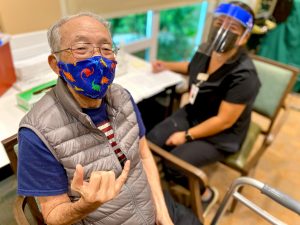Lessons from the pandemic for a Hawai‘i 2.0 future
Posted on Mar 1, 2021 in Capitol Connection, FeaturedCOVID-19 case counts are down. Vaccinations are up. And every day is moving us closer to a “new normal.” But the new Hawai‘i needs to be stronger and better than before, based on the lessons from the pandemic. Do we have what it takes to create a better future while making sure no one gets left behind? Governor Ige and his team, legislators and key community members are seeking answers to this question, and they’re looking for help from all of us to create a Hawai‘i 2.0.
Q. What do you want people to know about our current vaccination plans?
A. So far, the vaccine rollout has been going smoothly, but the biggest challenge for Hawai‘i and all the states is we need more doses. We have 100 vaccination sites statewide that could scale up quickly. We could administer double the number of doses we’re currently receiving from the federal
government. The faster we can receive more supply, the faster we can vaccinate people in the next priority groups.
Q. What is the state doing to guard against the COVID variants?
A. We’re one of the few states that have the total capability to identify these variants quickly to curb any spread. The good news is the same precautions that we’ve taken since the start of the pandemic still work for the variants. They include wearing masks, washing hands, staying home when you’re sick, watching your distance and avoiding large groups.
Q. Is the state budget forecast looking better? What additional help is available for families and the unemployed?
A. We’re cautiously optimistic about the state’s economic recovery, but we still have a significant budget shortfall. The federal government did pass a funding package in December with aid to schools, vaccination support, rent relief, help for businesses and broadband expansion. We’re hoping for more aid in the months ahead. We’re doing the best we can to update unemployment benefits in our antiquated system, and I’ve extended the eviction moratorium for another 60 days. The most recent Council on Revenues forecast was better. However, our general fund revenues are still down 9.4 percent over last year, and we still have loans to repay to cover unemployment insurance and state payroll. Our best hope is additional federal aid to the states to cover shortfalls and maintain critical public services.
Q. Why is this a historic moment to drive change in the state?
A. The Hawai‘i 2.0 initiative I described in my State of the State speech is asking different community sectors, “What did we learn in the past year and does it change the state’s priorities?” We don’t want to reinvent the wheel. We’re looking to develop a program of action and apply a COVID lens to what has been an enormous transformation of the world as we knew it. One example is the need for broadband since virtually everyone had to go online during the pandemic. We found, without connectivity, many people were at a huge disadvantage. The good news is we are already looking at ways to fix this, including the work of the Broadband Hui and pilot projects such as the one in the state Department of Transportation to extend the reach to more people on all islands (see stories inside).

